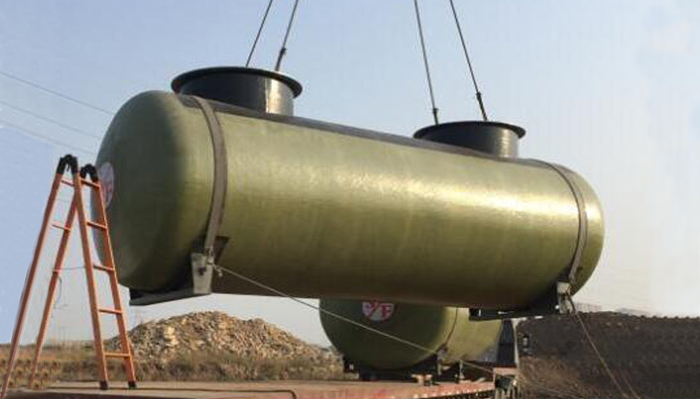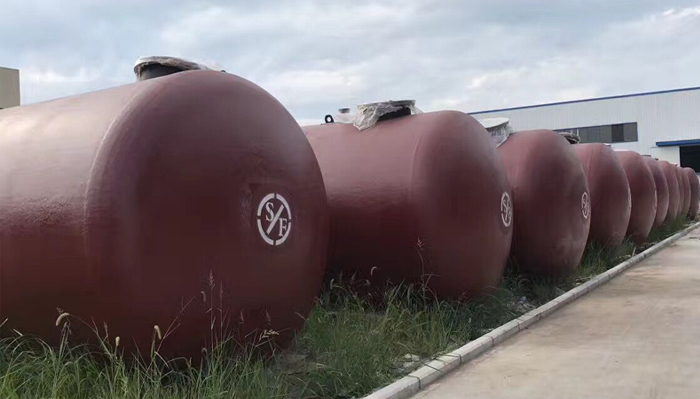Product Category
Fire protection requirements of double oil tanks
Date: Jan 22, 2020

Fire protection requirements of double oil tanks
(1) Gasoline and diesel storage tanks shall be horizontal cylindrical steel tanks, and diesel storage tanks shall be directly buried underground. It is strictly prohibited to set the storage tank indoors or in the pit covered by the cover plate. The tank capacity should not be too large. In areas with high building density, a single type of tank should be used, and the tank capacity should not exceed 10m3
(2) When the double-layer oil tank is directly buried in the ground, there is no fire dike.
(3) The oil inlet pipe, oil measuring hole, breathing pipe and other joint pipes of the direct buried oil tank shall be set on the manhole cover, and the oil measuring hole shall be made of copper, aluminum and other non-ferrous metal ruler groove to prevent the steel ruler and steel pipe from friction and fire.
(4) The underground fuel tank shall be equipped with a separate breathing pipe with a diameter of no less than 50mm; the breathing pipe must be equipped with a flame arrester, and the distance between the pipe orifice and the ground shall not be less than 4m. For the breathing pipe laid on the wall (column) of the lead building, its nozzle shall be 1 m higher than the building, and the clear distance from the door and window shall not be less than 3 m.
(5) The underground oil pipe hole shall be set in a solid operation well. The well cover shall be made of materials that do not produce sparks during collision.
(6) The steel oil tank must be grounded for lightning protection. Its grounding point shall be no less than 2, and the grounding resistance shall not be greater than 10 Ω. When the oil tank is only used for anti induction lightning grounding, the grounding resistance should not be greater than 30 Ω. The steel fuel tank equipped with flame arrester can not be equipped with lightning rod (wire) protection. The tank body, oil measuring hole and other metal accessories of the buried oil tank shall be electrically connected and grounded, and the grounding resistance shall not be greater than 10 Ω. The underground steel tank for storing combustible oil can only be used for anti induction lightning grounding.
(7) Two groups of grounding devices shall be set at both ends of the underground horizontal oil tank, and the resistance value shall not be greater than 10 Ω. The connection flat iron or conductor between the tank body and the grounding electrode shall be connected by bolts, and anti-corrosion treatment such as asphalt shall be carried out. The electrostatic grounding device shall be tested twice a year. Fire prevention and management requirements in operation
Fire prevention and management requirements in operation
1. General management requirements
(1) The operator shall master the operation technology and fire safety regulations of the post, and operate carefully to prevent oil leakage.
(2) No fireworks are allowed in the tank farm, and eye-catching billboards are set up to strictly manage the power and water consumption. It is strictly prohibited to carry out operations that may generate sparks in the gas station, such as vehicle maintenance, iron knocking, etc.
(3) The safety net, breather valve and grounding wire shall be inspected and tested frequently to ensure safety and easy use.
(4) It is strictly prohibited to bring all dangerous goods into the station; it is strictly prohibited for miscellaneous personnel to enter and stay at will in the gas station. When the tube car enters the station to refuel, the passengers must get off first, and then get on again after the refuelling is completed.
(5) Refueling and unloading operations shall be stopped in case of lightning stroke.
2. Fire protection for oil unloading operation
Unloading oil from tank car to underground oil tank is a working process with the greatest fire risk in tank farm. According to the regulations, the method of oil unloading must be closed, but there is still the phenomenon of using the high-level difference of tank car to open self flow oil unloading. This will cause a large amount of oil vapor to escape from the oil inlet, oil metering port and vent pipe of the oil tank. The mixture of oil vapor and air will burn and explode when encountering the fire source. In the process of unloading, it is easy to generate static electricity. Therefore, special attention must be paid to the fire safety during the open oil unloading operation.
(1) The exhaust pipe of the tank car shall be equipped with a fire cover. The engine should be shut down during the self flow unloading. At the same time, stop refueling operations (except for those separated from the tank farm and refueling area), do a good job of safety alert, and timely arrange the unloading.
(2) When unloading the oil from the tank car, special personnel shall be assigned for supervision. The driver shall first connect the temporary ground wire at the specified position of the tank car, and stick to the post to prevent pedestrians from approaching. After unloading and stabilizing the oil for 5min, retest the storage capacity of the oil tank to prevent the electrostatic discharge between the dipstick and the oil level and the oil tank from causing a disaster.
(3) Before unloading, the oil tank must be measured, and the oil can be unloaded only after checking the oil storage capacity of the tank, so as to prevent the oil from falling off the roof during unloading. During unloading, the flow of oil shall be strictly controlled. Before the oil product is flooded into the oil pipe, the flow rate of oil shall be controlled within 0.71m/s to prevent static electricity.
(4) During oil unloading, the oil pipe shall extend to the bottom of the tank no more than 300 mm to prevent static electricity generated by oil splashing. According to the experience of some areas, changing a section of oil unloading pipe into a flower pipe can prevent oil splashing.
(1) Gasoline and diesel storage tanks shall be horizontal cylindrical steel tanks, and diesel storage tanks shall be directly buried underground. It is strictly prohibited to set the storage tank indoors or in the pit covered by the cover plate. The tank capacity should not be too large. In areas with high building density, a single type of tank should be used, and the tank capacity should not exceed 10m3
(2) When the double-layer oil tank is directly buried in the ground, there is no fire dike.
(3) The oil inlet pipe, oil measuring hole, breathing pipe and other joint pipes of the direct buried oil tank shall be set on the manhole cover, and the oil measuring hole shall be made of copper, aluminum and other non-ferrous metal ruler groove to prevent the steel ruler and steel pipe from friction and fire.
(4) The underground fuel tank shall be equipped with a separate breathing pipe with a diameter of no less than 50mm; the breathing pipe must be equipped with a flame arrester, and the distance between the pipe orifice and the ground shall not be less than 4m. For the breathing pipe laid on the wall (column) of the lead building, its nozzle shall be 1 m higher than the building, and the clear distance from the door and window shall not be less than 3 m.
(5) The underground oil pipe hole shall be set in a solid operation well. The well cover shall be made of materials that do not produce sparks during collision.
(6) The steel oil tank must be grounded for lightning protection. Its grounding point shall be no less than 2, and the grounding resistance shall not be greater than 10 Ω. When the oil tank is only used for anti induction lightning grounding, the grounding resistance should not be greater than 30 Ω. The steel fuel tank equipped with flame arrester can not be equipped with lightning rod (wire) protection. The tank body, oil measuring hole and other metal accessories of the buried oil tank shall be electrically connected and grounded, and the grounding resistance shall not be greater than 10 Ω. The underground steel tank for storing combustible oil can only be used for anti induction lightning grounding.
(7) Two groups of grounding devices shall be set at both ends of the underground horizontal oil tank, and the resistance value shall not be greater than 10 Ω. The connection flat iron or conductor between the tank body and the grounding electrode shall be connected by bolts, and anti-corrosion treatment such as asphalt shall be carried out. The electrostatic grounding device shall be tested twice a year.

1. General management requirements
(1) The operator shall master the operation technology and fire safety regulations of the post, and operate carefully to prevent oil leakage.
(2) No fireworks are allowed in the tank farm, and eye-catching billboards are set up to strictly manage the power and water consumption. It is strictly prohibited to carry out operations that may generate sparks in the gas station, such as vehicle maintenance, iron knocking, etc.
(3) The safety net, breather valve and grounding wire shall be inspected and tested frequently to ensure safety and easy use.
(4) It is strictly prohibited to bring all dangerous goods into the station; it is strictly prohibited for miscellaneous personnel to enter and stay at will in the gas station. When the tube car enters the station to refuel, the passengers must get off first, and then get on again after the refuelling is completed.
(5) Refueling and unloading operations shall be stopped in case of lightning stroke.
2. Fire protection for oil unloading operation
Unloading oil from tank car to underground oil tank is a working process with the greatest fire risk in tank farm. According to the regulations, the method of oil unloading must be closed, but there is still the phenomenon of using the high-level difference of tank car to open self flow oil unloading. This will cause a large amount of oil vapor to escape from the oil inlet, oil metering port and vent pipe of the oil tank. The mixture of oil vapor and air will burn and explode when encountering the fire source. In the process of unloading, it is easy to generate static electricity. Therefore, special attention must be paid to the fire safety during the open oil unloading operation.
(1) The exhaust pipe of the tank car shall be equipped with a fire cover. The engine should be shut down during the self flow unloading. At the same time, stop refueling operations (except for those separated from the tank farm and refueling area), do a good job of safety alert, and timely arrange the unloading.
(2) When unloading the oil from the tank car, special personnel shall be assigned for supervision. The driver shall first connect the temporary ground wire at the specified position of the tank car, and stick to the post to prevent pedestrians from approaching. After unloading and stabilizing the oil for 5min, retest the storage capacity of the oil tank to prevent the electrostatic discharge between the dipstick and the oil level and the oil tank from causing a disaster.
(3) Before unloading, the oil tank must be measured, and the oil can be unloaded only after checking the oil storage capacity of the tank, so as to prevent the oil from falling off the roof during unloading. During unloading, the flow of oil shall be strictly controlled. Before the oil product is flooded into the oil pipe, the flow rate of oil shall be controlled within 0.71m/s to prevent static electricity.
(4) During oil unloading, the oil pipe shall extend to the bottom of the tank no more than 300 mm to prevent static electricity generated by oil splashing. According to the experience of some areas, changing a section of oil unloading pipe into a flower pipe can prevent oil splashing.
Last article:
Send Your Inquiry
We not only provide a good product, but also provide high quality service. If you are interested in our products,
you can contact us in the following ways.
you can contact us in the following ways.















































































































